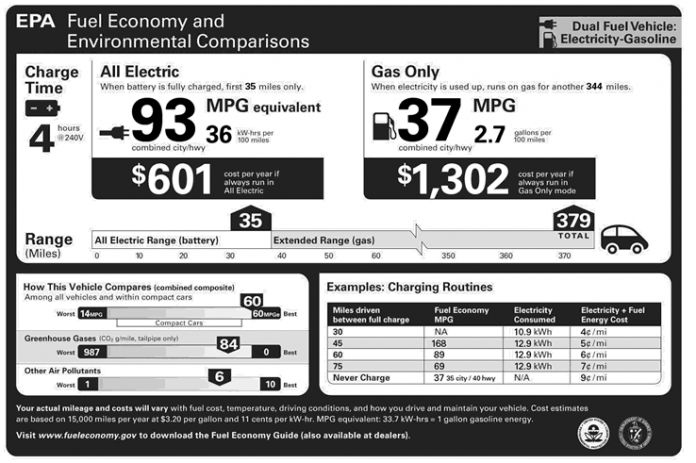By Marlo Lewis
The U.S. Environmental Protection Agency (EPA) today announced new, greenhouse gas (GHG) emission standards for light- and medium-duty vehicles. The standards would increase in stringency each year during model years (MYs) 2027-2032. The GHG standards are calibrated in grams of carbon dioxide (CO2) per mile. By MY 2032, the proposed light-duty vehicle (passenger car and light truck) standards are projected to reduce fleet-average GHG emissions by 56 percent compared to the existing MY 2026 standards adopted in 2021. According to the agency’s press release, electric vehicles could account for 67 percent of all new light-duty sales in MY 2032, compared to 8.4 percent in 2022.
Although the EPA’s proposal is ostensibly “technology neutral,” it is a de-facto vehicle electrification mandate, because dramatically increasing the market shares of battery electric vehicles (BEVs) and plug-in hybrid electric vehicles (PHEVs) is the most feasible and affordable way to comply with the aggressive new standards.
A great deal could be said at this point about the cost and inconvenience the regulatory suppression of internal combustion engine (ICE) vehicles will impose on consumers and the economy. My concern in this post is whether the EPA’s proposal is even legal. It is not, as explained below.
Our inquiry properly begins with the Supreme Court’s decision in Massachusetts v. EPA (2007). That decision, which set the stage for all EPA regulation of GHG emissions, elevated the agency from compliance tester to decisionmaker in federal fuel economy regulation.
The immediate issue addressed in Massachusetts was whether the Clean Air Act authorizes the EPA to regulate GHG emissions from new motor vehicles. An important technical fact to bear in mind is that CO2 emissions from motor fuel consumption constitute about 94 percent of all light-duty vehicle GHG emissions (including hydrofluorocarbon emissions from vehicle air conditioners).
In Massachusetts, the G.W. Bush administration and its allies argued that Congress had already delegated the authority to regulate tailpipe CO2 emissions to the National Highway Traffic Safety Administration (NHTSA), the nation’s fuel economy regulator. They reasoned as follows. A vehicle’s CO2 emissions per mile are physically and mathematically proportional to its fuel consumption per mile. Thus, regulating fuel economy (calibrated in miles per gallon) also regulates tailpipe emissions (calibrated in grams of CO2 per mile), and vice versa. And Congress authorized NHTSA, not the EPA, to regulate fuel economy.
Indeed, Title V of the Energy Policy and Conservation Act (EPCA) provides detailed instructions for NHTSA’s administration of federal fuel economy standards. In contrast, the Clean Air Act contains no Title, section, or subsection devoted to fuel economy.
The Court’s 5-4 majority dismissed that objection in one sentence, opining that while the EPA’s and NHTSA’s responsibilities may overlap, “there is no reason to think the two agencies cannot both administer their obligations and yet avoid inconsistency.” It should now be clear that the Court was mistaken.
In 2007, Congress amended EPCA to prohibit NHTSA from considering the fuel economy of “dedicated” (alternative fuel) vehicles—a category that includes electric vehicles—when setting maximum feasible mileage standards. The purpose was to ensure fuel economy standards do not become so stringent that automakers cannot comply without significant electrification of their fleets. But that is effectively what the EPA now proposes to do by promulgating aggressive CO2 emission standards that inherently regulate fleet average fuel economy.
Contrary to what the Court predicted, the EPA’s new proposal is fundamentally inconsistent with the fuel economy scheme Congress designed and authorized NHTSA to administer.
If finalized, the EPA’s proposal will be challenged in Court. The major questions doctrine will likely be front and center. Where does the Clean Air Act provide a clear statement authorizing the EPA to electrify the U.S. motor vehicle fleet and upend the statutory scheme Congress enacted in EPCA?
The EPA will likely argue that tax credits and other subsidies in the 2021 Bipartisan Infrastructure Law (BIL) and 2022 Inflation Reduction Act (IRA) provide a clear statement of Congress’s support for vehicle electrification. That won’t wash. Statutory authority is chiefly a matter of means, not ends. The BIL and IRA authorize specific types of subsidies. They are not broad authorizations to pursue electrification by any means necessary. Most critically, the BIL and IRA do not change any regulatory provision of the Clean Air Act. They do not authorize the EPA to regulate ICE vehicles out of the U.S. transportation sector.
The EPA’s de-facto EV mandate is too clever by half. In the past, the Supreme Court has declined to relitigate Massachusetts v. EPA. Thanks to the EPA’s latest overreach, the conservative majority on the Court may get an opportunity to do just that.
Marlo Lewis is a senior fellow with the Competitive Enterprise Institute and a policy advisor to The Heartland Institute.
This article was originally published by the Competitive Enterprise Institute and is reposted with permission.
For more on vehicle efficiency standards, click here.
For more on electric vehicles, click here.


























